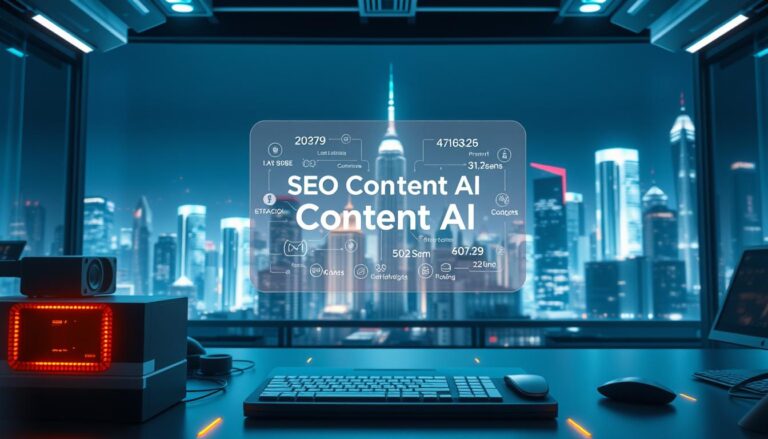In the world of digital marketing, on-page optimization is key. It helps your website rank higher and get more visitors. Using SEO best practices is crucial. This includes making your website easy to navigate and understand.
Google looks at how well your website is set up and the quality of your content. A good on-page optimization plan can bring in more visitors. It also makes your website better for users.
Key Takeaways
- On-page optimization is essential for improving rankings and driving traffic.
- Including target keywords in title tags enhances relevance and click-through rates.
- Unique and high-quality content provides “information gain” necessary for high rankings.
- Effective meta descriptions can increase organic click-through rates.
- Image optimization, including unique images and relevant filenames, supports SEO efforts.
- Internal linking from authoritative pages aids in enhancing overall site rankings.
Understanding On-Page Optimization
On-page optimization is about making a website better for search engines. It focuses on things like title tags, content quality, and how links work inside the site. By using SEO tips, websites can become more relevant to what people search for. This leads to more visitors and better interaction.
Definitions and Importance
On-page optimization means making a website better for search rankings. It includes fast page loads, good source code, and smart use of meta tags. It’s important to keep checking and improving these things to avoid losing rankings.
It’s not just about text. Things like headings, bullet points, and images are also important. They help with rankings in Google’s image search too.
Difference Between On-Page and Off-Page SEO
On-page optimization works on the website itself. Off-page SEO is about what happens outside the site, like backlinks and social media. On-page focuses on creating content that’s easy to read and meets user needs.
Off-page builds a website’s authority with links and mentions. Using both on-page and off-page strategies is key to a strong SEO plan.
Why On-Page Optimization Matters for SEO
On-page optimization is key for a website’s visibility and user happiness. It focuses on important things like title tags, meta descriptions, and content quality. This effort boosts search engine rankings and makes users happy.
With a well-optimized site, users are more likely to engage, stay longer, and convert.
Enhanced Search Engine Visibility
More than 75% of users don’t go past the first page of search results. This shows how crucial on-page optimization is. Websites with good title tags and meta descriptions see up to a 30% increase in clicks.
A well-structured URL can boost click-through rates by up to 45%. This highlights the need for detail in making a website more visible online.
Improved User Experience
Fast loading times and mobile-friendly designs are vital for a good user experience. Pages that load in two seconds see a 9% higher conversion rate. Mobile devices make up over half of all internet traffic, so Google favors mobile-friendly sites.
Internal linking can make users spend 40% more time on a site. This shows how on-page optimization boosts engagement and satisfaction.
Essential Elements of Effective On-Page Optimization
On-page optimization has many key parts. These include using meta tags, title tags, and meta descriptions well. They help a website show up better in searches. This makes the site work better and get more clicks.
Meta Tags and Their Importance
Meta tags give a quick summary of a webpage. They help search engines and users understand the page’s content. Using them right can really help a website rank higher.
Title Tags Optimization Strategies
Optimizing title tags is very important. Putting keywords at the start helps search engines see the page’s focus. Good title tags can make a page rank higher and get more clicks.
Crafting Engaging Meta Descriptions
Writing meta descriptions is a challenge. You need to be brief but still make it interesting. A good meta description can make people want to click on the page. It can even increase clicks by up to 5.8%.

Content Optimization Techniques
Good content optimization is key to being seen online and keeping users interested. Making content that meets user needs is crucial for better search rankings and more visitors. It’s all about giving useful info and making users happy.
Creating High-Quality, Valuable Content
Creating content that people want to read is essential. Writing articles that are helpful and informative builds trust. This trust is important for search engines and helps your site rank better.
Google looks for content that shows E-E-A-T—Experience, Expertise, Authoritativeness, and Trustworthiness. Following this helps users stay on your site longer. This means your site does better in search results.
Keyword Placement and Density
Putting keywords in the right places is important. Using keywords in the first 100 words helps you show up more in search results. But, don’t stuff keywords. It makes your content hard to read and can hurt your ranking.
Doing good keyword research helps you find the right words. This makes your content more effective. Also, clear URLs help users find what they need faster. This makes for a better experience.
Header Tags and Their Role in On-Page SEO
Header tags help organize content for both people and search engines. They make content easy to read and navigate. Google’s John Mueller says header tags tell search engines about a page’s topics.
By making these tags better, you can make users happy. Google likes happy users and gives them better rankings.
Using H1, H2, and H3 Tags Effectively
HTML has many header tags, but using them right is key. Use only one H1 tag per page to state the main topic. Then, H2 and H3 tags are for subtopics, keeping things neat and easy to scan.
Studies show that well-organized content does better in search results. Google likes content that’s easy for users to follow.
Good header tags make content easier to read and can get more clicks. When content is well-organized, it meets user needs better. This can lead to more chances of showing up in featured snippets, making you more visible online.
Image Optimization for Better SEO
Optimizing images is key to a better website. It makes your site faster and more user-friendly. The right steps can boost your site’s ranking and keep users engaged.
Importance of Alt Text and Descriptive Filenames
Alt text is crucial for SEO. It helps search engines understand your images. It also makes your site more accessible to everyone.
Keep alt text short, under 125 characters. This helps assistive technologies work better.
Descriptive filenames are also important. They give Google clues about your images. Use keywords and hyphens instead of spaces.

Think about file size and format when optimizing images. Compressing images makes them load faster. Use JPEG and PNG formats for quality.
Structured data can make your images stand out in Google Images. Use tools like Semrush to check for optimization issues.
| Optimization Element | Best Practices |
|---|---|
| Alt Text | Use relevant keywords, keep it under 125 characters. |
| Descriptive Filenames | Incorporate keywords, use hyphens to separate words. |
| Image Format | Use high-quality formats like JPEG and PNG. |
| File Size | Optimize to improve load times; aim for less than 350 KB. |
| Responsive Images | Implement srcset and element for various screen sizes. |
Using these image optimization tips is vital. They improve your site’s visibility and user experience. Optimizing images well ensures your content reaches more people while keeping your site fast.
Internal Linking Strategies
Internal linking is key to making your website better. It helps both users and search engines find what they need. By linking pages together, you make your site easier to use and understand.
A good internal linking plan can boost your site’s SEO. This means more people will see your site when they search online.
Building a Web of Relevant Pages
Link from important pages to other useful content. Google likes sites with lots of internal links. This shows your site is valuable.
Check your links often to make sure all content is reachable. If pages are hard to find, they might not get seen by search engines. Make your site easy to navigate to keep people interested.
Using Keyword-Rich Anchor Text
Choosing the right anchor text is important for SEO. It helps both users and search engines understand your links. Google suggests using clear text for better understanding.
Put two to three links on each new page. This helps your site seem more important. Update your linking plan often to keep your site healthy.
Use tools like Yoast SEO to help with your links. These tools can suggest links and count them for you. Good linking makes it easier for everyone to find related content, which can help your site rank better.
| Strategy | Benefit |
|---|---|
| Link from high-authority pages | Increases the perceived importance of linked content |
| Use descriptive anchor text | Improves clarity for users and search engines |
| Regular audits | Identifies and manages orphaned content |
| Aim for 2-3 internal links per new post | Enhances visibility and traffic |
| Contextual linking | Facilitates easier navigation and improves user experience |
External Links: Establishing Authority
External links are key to making a website more authoritative. By adding good external links, you tell search engines your site is reliable and valuable. This boosts both user trust and your site’s authority.
Quality external links give context to your content. They also help users find more information.
Citing Reputable Sources
Citing trusted sources is crucial for your website’s credibility. Surveys show external links are the most important for high rankings. Linking to respected sites shows your content is trustworthy.
Pages with many links from good sources rank higher. This is because Google sees them as more popular.
The Role of External Links in SEO
External links are important signals of quality for search engines. Google sees them as votes of confidence. This means the linked page’s content is credible and valuable.
It’s important to optimize your anchor text. Descriptive links improve user experience and SEO. A mix of anchor text is key to avoid spam detection.
Keep an eye on your external links to keep them quality. Bad links can hurt your SEO. By focusing on quality, you can boost your online presence.
The Impact of URL Structure on On-Page Optimization
Understanding URL structure is key for a good website. A well-organized URL structure boosts search engine visibility and user experience. It also helps with click-through rates and organic traffic.
Best Practices for SEO-Friendly URLs
SEO-friendly URLs are important for both users and search engines. Here are some tips:
| Practice | Description | Impact on SEO |
|---|---|---|
| Keep URLs Short | Avoid long URLs; aim for short and clear ones. | Users click more and understand better. |
| Use Keywords | Put in keywords that match the page’s content. | Get up to 45% more organic traffic. |
| Utilize Hyphens | Use hyphens between words instead of underscores. | Search engines index better and users read easier. |
| Avoid Special Characters | Stay away from complex or unnecessary characters. | Users stay longer and trust the site more. |
| Logical Hierarchy | Make URLs follow a logical order that shows content hierarchy. | Users navigate better and understand the site. |
Following these tips helps businesses rank better in search results. A clear URL structure helps both search engines and users. It shows what the page is about and its relevance.
Mobile Optimization: Why It’s Crucial
Mobile searches now beat desktop searches. A responsive design is key for a smooth user experience. Without it, businesses lose out on traffic and customers.
Responsive Design and User Experience
A responsive design changes to fit any screen size. This is vital since over 50% of internet traffic is mobile. Poor mobile sites lead to users leaving quickly.
By making mobile sites better, you can keep users longer. This means they can find what they need without trouble.
The Effect of Mobile Optimization on SEO
In 2015, Google started using mobile versions first for search results. This shows how important mobile optimization is for ranking. Sites not mobile-friendly don’t show up as well.
Slow sites also make users leave fast. This hurts your SEO even more. Using Accelerated Mobile Pages (AMP) can make mobile sites better and help SEO too.
Conclusion
On-page optimization is key for SEO success. It helps bring in more traffic and makes users happy. By working on meta tags, titles, and mobile friendliness, sites can climb higher in search results.
Google gets over 31.3% of all clicks for certain searches. So, knowing how to optimize on-page is crucial for any digital marketing plan. It helps get more organic traffic.
Using SEO best practices like making content engaging and optimizing images also helps a lot. Studies show that good meta descriptions can increase clicks by 56%. The top spots in search results can see a 32% jump in clicks.
These findings highlight the need for careful website optimization. It’s vital for getting noticed and attracting customers.
In short, using on-page optimization well boosts search rankings and improves user experience. This is key for keeping users interested and reducing them leaving early. As the online world gets more crowded, focusing on these strategies is essential. It helps websites stand out and connect better with their audience.
Source Links
- On-Page SEO: The Definitive Guide + FREE Template (2025) – https://backlinko.com/on-page-seo
- On-Page SEO: The Complete Guide for 2025 – WordStream – https://www.wordstream.com/blog/ws/2022/04/06/on-page-seo
- Onpage Optimization Definition – SEO Glossary – https://www.conductor.com/academy/glossary/on-page-optimization/
- On-Page SEO: What It Is and How to Do It – https://www.semrush.com/blog/on-page-seo/
- What Is On-Page SEO? How To Optimize A Page – https://moz.com/learn/seo/on-site-seo
- On-Page SEO: What it is, Why it Matters, & How To Optimize | Clearscope – https://www.clearscope.io/blog/on-page-seo
- 13 Essential On-Page SEO Factors You Need To Know – https://www.searchenginejournal.com/on-page-seo/essential-factors/
- 10 Elements of a Highly Effective On-Page SEO – https://devrix.com/tutorial/10-elements-highly-effective-on-page-seo/
- The 5 Keys To Effective On-Page SEO – https://www.forbes.com/councils/forbesbusinesscouncil/2022/10/11/the-5-keys-to-effective-on-page-seo/
- Your Guide to On-Page SEO and Content Optimization – https://www.conductor.com/academy/on-page-seo-content/
- SEO Starter Guide: The Basics | Google Search Central | Documentation | Google for Developers – https://developers.google.com/search/docs/fundamentals/seo-starter-guide
- How To Use Header Tags: SEO Best Practices – https://www.searchenginejournal.com/on-page-seo/header-tags/
- Impact of Header Tags on On-Page SEO – Bliss Drive – https://www.blissdrive.com/seo/impact-of-header-tags-on-on-page-seo/
- On-page SEO: The Definitive Guide for 2023 | The Egg – https://www.theegg.com/seo/apac/on-page-seo-the-definitive-guide-for-2023/
- Image SEO Best Practices | Google Search Central | Documentation | Google for Developers – https://developers.google.com/search/docs/appearance/google-images
- Image SEO: How to Optimize Images for Search Engines & Users – https://www.semrush.com/blog/image-seo/
- SEO: How To Optimize Images for the Web – https://contentmarketinginstitute.com/articles/optimize-images-seo/
- Internal linking for SEO: Why and how? – https://yoast.com/internal-linking-for-seo-why-and-how/
- Internal Linking for SEO: The Complete Guide – https://backlinko.com/hub/seo/internal-links
- Internal Links: Ultimate Guide + Strategies – https://www.semrush.com/blog/internal-links/
- What Are External Links? Best Practices For Building Authority – https://moz.com/learn/seo/external-link
- What Is an External Link? + SEO Best Practices – https://www.semrush.com/blog/external-links/
- External Linking for SEO: A Complete Guide – https://marketbrew.ai/external-linking-for-seo-a-complete-guide
- The Complete Guide to On-Page SEO – https://www.searchenginejournal.com/on-page-seo/
- On-Page SEO: How to Optimize for Robots and Readers – https://ahrefs.com/blog/on-page-seo/
- What is On-Page SEO Optimization and How to Implement | Mailchimp – https://mailchimp.com/resources/all-about-on-page-seo/
- Mobile Optimization: Why It’s Important for SEO Rankings – https://blueinteractiveagency.com/seo-blog/2023/05/the-impact-of-mobile-optimization-on-seo-rankings/
- Why is Mobile Optimization Important For Website Conversions? | VWO – https://vwo.com/website-optimization/mobile-optimization-importance/
- Complete Guide to On-Page SEO Optimization in 2024 | ResultFirst – https://www.resultfirst.com/blog/seo-basics/the-complete-guide-to-on-page-seo-optimization/
- %%title%% – GeeksforGeeks – https://www.geeksforgeeks.org/on-page-seo-optimization/
Related Posts
- Best SEO Plugins for WordPress in 2025: Optimize Content, Boost Rankings, and Get Found
- How to Improve Website SEO and Rank Website on Google
- Shopify SEO – How to Optimize Your Shopify Website For Search Engines
- Fastest Cloud Hosting for WordPress in 2025: Scalable and Secure Options
- Best WooCommerce SEO Plugins to Maximize Product Visibility
- Link Tracking Plugins for Affiliate Marketers: Top 5 WordPress Tools
- Find the Best PBN Hosting Solution for Your Needs
- Keyword Finder: The Ultimate SEO Weapon







